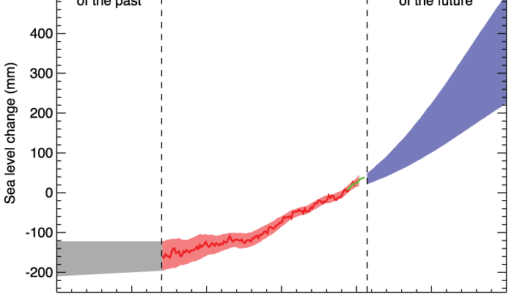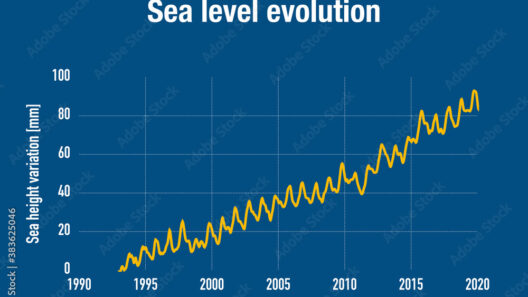Rising sea levels represent one of the most palpable consequences of climate change, directly affecting human societies around the globe. As glaciers melt and ocean waters expand due to increased temperatures, coastal communities grapple with the multifaceted ramifications of encroaching seas. This phenomenon is not merely an environmental issue; it embodies a confluence of social and economic challenges that demand comprehensive exploration.
Understanding the intricacies of rising sea levels reveals not only the immediate threats posed to inhabited areas but also the broader sociopolitical and economic implications that follow. This discourse endeavors to shed light on the pervasive impacts of this crisis.
Impending Displacement: The Human Toll of Coastal Erosion
Perhaps the most alarming consequence of rising sea levels is the potential displacement of millions of individuals. In low-lying regions such as Bangladesh, the Maldives, and parts of the United States, rising waters threaten to submerge homes, agricultural lands, and basic infrastructure. The phenomenon of climate-induced migration is swiftly becoming a reality, as families find themselves forced to abandon their properties and relocate to safer areas. Beyond the immediate loss of a home, this displacement can sever social networks, disrupt community cohesion, and engender mental health stresses among affected populations.
Moreover, there is an insidious aspect to this displacement that often goes overlooked: the concept of “climate refugees.” While traditional refugee categories exist for those fleeing war or persecution, no such legal framework formally recognizes those uprooted by climate events. This lack of classification exacerbates the vulnerabilities of marginalized communities, placing them at the mercy of government policies and socioeconomic inequities. The struggle for recognition and protection is compounded by the growing stigma attached to displaced populations, which further isolates them within their new communities.
Economic Implications: Disruption and Opportunity
The economic repercussions of rising sea levels are profound and vast. Coastal areas are often economic powerhouses, housing critical infrastructure, shipping ports, tourism destinations, and fishing industries. The encroachment of ocean waters poses a significant risk to these economic lifelines. For instance, infrastructure such as roads, bridges, and public services could be at risk of inundation, necessitating costly adaptations or repairs. The financial burden on local governments and taxpayers is staggering, as they face the dual challenges of fortifying existing structures while also planning for future resilience.
In tourism-dependent areas, the threat of rising seas could lead to a diminished appeal for visitors, impacting jobs and livelihoods reliant on seasonal travel. Beach erosion and loss of natural habitats can tarnish pristine environments, once considered idyllic escapes. Economically, this destabilization creates a ripple effect that reverberates through various sectors, from hospitality to retail, forcing communities to rethink their economic positioning in the face of water encroachment.
However, amidst potential devastation lies an avenue for innovation. Rising sea levels prompt a recalibration of urban development strategies, fostering opportunities for sustainable architecture and engineering. Innovations such as elevated buildings, flood-resistant designs, and green infrastructure could create jobs in the burgeoning field of climate resilience. While short-term challenges prevail, the quest for adaptation can also lead to long-term economic resilience if managed correctly.
Health Hazards: Rising Seas and Human Well-Being
The implications of rising sea levels extend beyond physical displacement and economic disruption, reaching into the realm of public health. As salinity increases due to coastal flooding, freshwater resources risk contamination, threatening access to potable water. Mishaps in water quality elevate the potential for waterborne diseases, compounding health challenges in already vulnerable populations.
Furthermore, as populations migrate from coastal areas, cities and regions that accept newcomers may become overwhelmed, stretching health care resources and infrastructure. Furthermore, mental health issues may proliferate as individuals grapple with loss and uncertainty. Anxiety and depression can compound due to the stressors associated with migration, disrupted community ties, and economic instability.
Rising sea levels also exacerbate existing health inequalities. Low-income communities often lack the resources to adapt effectively, rendering them particularly susceptible to the burgeoning sea-sourced threats. The intersection of climate change and social inequity prompts a vitally important dialogue about the responsibilities societies hold toward one another in addressing these challenges.
Conclusion: Towards a Concerted Response
To mitigate the extensive consequences of rising sea levels, a proactive and unified response is essential. This involves not only immediate actions to protect vulnerable populations but also longer-term investment in infrastructure, sustainable practices, and community education.
Collaboration between governments, non-governmental organizations, and affected communities can foster innovative solutions. By acknowledging the intricate tapestry of social, economic, and health implications tied to rising seas, society can cultivate resilience in the face of an uncertain future.
As we delve deeper into the multifaceted impacts of escalating ocean levels, it becomes increasingly clear that the fight for environmental justice must intertwine with the broader struggle for equity and human rights. The time to act is now, for the health of our planet and the well-being of its inhabitants depend on a collective commitment to address this pressing challenge.








